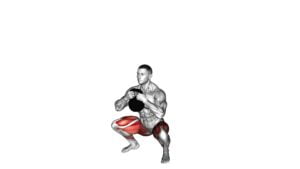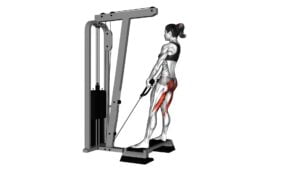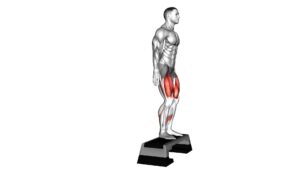Kettlebell Sumo Squat off Stepbox (male) – Video Exercise Guide & Tips

Get ready to level up your leg workout with the Kettlebell Sumo Squat off Stepbox.
Watch This Exercise Video
This exercise is perfect for targeting your glutes, quads, and hamstrings.
All you need is a kettlebell and a stepbox to get started.
Watch the video guide for proper form and technique, and discover variations to suit your fitness level.
Maximize the effectiveness of this exercise by following our expert tips.
Avoid common mistakes and get ready to feel the burn!
Key Takeaways
- The Kettlebell Sumo Squat targets multiple lower body muscles and adds resistance for increased intensity.
- The exercise requires a kettlebell and a stepbox to elevate the position and improve stability.
- Cost-effective options such as second-hand kettlebells, dumbbells, or filled water bottles can be used.
- Maintaining proper form and technique is crucial to prevent strain on the lower back and knees.
Benefits of the Kettlebell Sumo Squat
To maximize your workout, incorporating the kettlebell sumo squat can provide numerous benefits for building strength and enhancing lower body stability. This exercise targets multiple muscle groups, including the quadriceps, hamstrings, glutes, and calves. By performing the sumo squat with a kettlebell, you add resistance to the movement, increasing the intensity and making it more challenging. This helps to build muscle and improve overall lower body strength.
One of the main benefits of the kettlebell sumo squat is its ability to enhance lower body stability. By widening your stance and turning your toes outwards, you engage the muscles in your inner thighs, which are often overlooked in traditional squats. This helps to improve balance and stability, making it beneficial for athletes, as well as individuals looking to improve their overall fitness.
Another benefit of the kettlebell sumo squat is the ability to perform variations of the exercise. This allows you to target different muscle groups or add variety to your workout routine. Some variations include adding a pulse at the bottom of the squat, performing a sumo squat with a single kettlebell held in front of you, or incorporating a sumo squat jump for an added cardiovascular challenge.
Equipment Needed for the Exercise
To perform the kettlebell sumo squat off a stepbox, you'll need some essential exercise equipment.
The main item you'll need is a kettlebell, which can be easily purchased from fitness stores or online.
Additionally, you'll also need a stepbox or a sturdy platform to elevate your feet during the exercise.
These equipment options are cost-effective and easily accessible for anyone looking to incorporate the kettlebell sumo squat into their workout routine.
Essential Exercise Equipment
You'll need specific exercise equipment to perform the Kettlebell Sumo Squat off Stepbox (male) exercise.
This exercise variation requires a kettlebell and a stepbox. The kettlebell is essential for adding resistance and intensity to the squat movement. It allows you to challenge your lower body muscles and develop strength and power.
The stepbox is used to elevate your position, increasing the range of motion and targeting different muscle groups. It also helps improve stability and balance during the exercise.
It's crucial to use proper equipment to ensure safety and effectiveness during your workout.
Now, let's explore some cost-effective options available for those who want to try this exercise without breaking the bank.
Cost-Effective Options Available
Now, let's explore some cost-effective options for those wanting to try this exercise without overspending on equipment. Here are some low budget alternatives and inexpensive options:
- Kettlebell: Instead of purchasing a brand new kettlebell, consider checking out local garage sales, thrift stores, or online marketplaces for second-hand options. You can often find kettlebells in good condition at a fraction of the cost.
- Dumbbell: If you don't have access to a kettlebell, a dumbbell can be a suitable alternative. Look for adjustable dumbbells that allow you to increase or decrease the weight as needed.
- Water bottle: In a pinch, a filled water bottle can work as a makeshift weight for this exercise. Make sure the bottle is securely sealed to avoid any leakage during your workout.
Proper Form and Technique
Mastering proper form and technique is essential for performing the Kettlebell Sumo Squat off Stepbox effectively. When executing this exercise, it's important to maintain a wide stance with your feet turned outwards, ensuring that your knees track over your toes. This position engages your glutes, hamstrings, and quadriceps, providing a comprehensive lower body workout.
One common misconception is that the Kettlebell Sumo Squat off Stepbox is only beneficial for building leg strength. While it does target the lower body muscles, this exercise also engages the core and improves overall stability. By holding the kettlebell close to your chest, you activate your core muscles and challenge your balance.
However, it's important to be aware of the disadvantages of improper form. Using too heavy a weight or failing to maintain proper alignment can strain your lower back and knees. It's crucial to start with a weight that allows you to maintain good form throughout the exercise and gradually increase the weight as your strength and technique improve.
To ensure proper form, keep your chest lifted, shoulders back, and spine neutral throughout the movement. Avoid rounding your back or letting your knees collapse inward. Remember to engage your glutes and drive through your heels as you stand up from the squat position.
Variations and Modifications for Different Fitness Levels
To cater to different fitness levels, you can modify and vary the Kettlebell Sumo Squat off Stepbox exercise. Here are some variations and progressions for beginners:
- Different Squat Variations:
- Bodyweight Squat: If you're new to squats or just starting your fitness journey, you can begin with bodyweight squats. These squats help you build strength and proper form before adding weights.
- Goblet Squat: Once you're comfortable with bodyweight squats, you can progress to goblet squats. Hold a kettlebell close to your chest while performing the squat. This variation helps engage your core and upper body muscles.
- Front Squat: The front squat places the kettlebell in front of your body, resting on your shoulders. This variation targets your quads and core muscles even more intensely.
- Progressions for Beginners:
- Reduced Range of Motion: If you find it challenging to perform a full-depth squat, you can reduce the range of motion by squatting only halfway down. As your strength improves, gradually increase the depth of your squat.
- Lighter Kettlebell: Start with a lighter kettlebell and focus on mastering the squat technique before increasing the weight. This approach allows you to build a solid foundation and prevent injuries.
Remember to always listen to your body and progress at your own pace. Gradually increase the difficulty of the variations as you become more comfortable and confident with your squatting technique.
Tips for Maximizing the Effectiveness of the Exercise
To further enhance your workout and achieve optimal results, follow these tips to maximize the effectiveness of the Kettlebell Sumo Squat off Stepbox exercise.
First, make sure to choose an appropriate weight for the kettlebell. It should be challenging enough to push your muscles, but not too heavy that it compromises your form.
Additionally, focus on maintaining proper technique throughout the exercise. Keep your feet shoulder-width apart and toes pointed slightly outwards. As you squat down, ensure that your knees track over your toes and your back remains straight. Engage your core and squeeze your glutes at the top of the movement for maximum activation.
To further challenge yourself, you can try incorporating advanced techniques such as pausing at the bottom of the squat or adding a pulse at the top. These variations will increase the intensity and maximize your results.
Remember to listen to your body and progress at a pace that's comfortable for you.
Now that you know how to maximize the effectiveness of the Kettlebell Sumo Squat off Stepbox exercise, let's move on to the next section about common mistakes to avoid.
Common Mistakes to Avoid
To ensure proper form and avoid potential injury, it's important to be aware of common mistakes that can occur while performing the Kettlebell Sumo Squat off Stepbox exercise. Here are some common mistakes to avoid:
- Incorrect squat depth: One common mistake isn't squatting deep enough. It's important to lower your body until your thighs are parallel to the ground. This ensures that you engage the correct muscles and maximize the effectiveness of the exercise.
- Poor posture: Another mistake is having poor posture during the exercise. It's crucial to maintain a straight back and avoid rounding your shoulders. This helps to prevent unnecessary strain on your back and reduces the risk of injury.
To avoid injuries and enhance the effectiveness of the Kettlebell Sumo Squat off Stepbox exercise, proper breathing techniques are also important. Remember to exhale as you push through your heels and stand up, and inhale as you lower your body into the squat position. This helps to stabilize your core and maintain proper form throughout the exercise.
Frequently Asked Questions
How Heavy Should the Kettlebell Be for a Beginner to Start With?
When starting out with kettlebell sumo squats, it's important to choose the right weight. As a beginner, it's recommended to start with a lighter kettlebell to focus on proper form and technique. This will help you build a strong foundation and prevent injury.
Gradually increase the weight as you become more comfortable and confident with the exercise. Remember, the key is to maintain proper form throughout the movement to get the most out of your workout.
What Muscles Does the Kettlebell Sumo Squat Primarily Target?
The kettlebell sumo squat primarily targets the muscles of your lower body, including your quadriceps, hamstrings, glutes, and calves. It's a great exercise for building strength and stability in your legs.
There are also variations of the kettlebell sumo squat that can further target specific muscles. For example, you can try a single-leg kettlebell sumo squat to challenge your balance and engage your core.
Another variation is to add a kettlebell swing at the top of the movement to incorporate more explosive power.
Can the Kettlebell Sumo Squat Be Performed Without a Stepbox?
Yes, the kettlebell sumo squat can be performed without a stepbox. It's a versatile exercise that can be modified to suit your needs.
However, using a stepbox can provide additional benefits such as increased range of motion and stability.
If you don't have a stepbox, you can try alternative variations like performing the sumo squat on flat ground or using a bench. These variations can still target the same muscles and provide a challenging workout.
How Many Sets and Reps Should Be Performed During a Kettlebell Sumo Squat Workout?
To determine the number of sets and reps for a kettlebell sumo squat workout, consider your fitness level and goals. For beginners, start with 2-3 sets of 8-10 reps. As you progress, increase to 3-4 sets of 10-12 reps.
To modify the exercise, use lighter kettlebells or perform bodyweight squats.
Remember to maintain proper form and technique by keeping your back straight, knees aligned with toes, and lowering your hips until your thighs are parallel to the ground.
Are There Any Specific Warm-Up Exercises Recommended Before Performing the Kettlebell Sumo Squat?
Before performing the kettlebell sumo squat, it's important to warm up your body properly. Start with a dynamic warm-up, such as jumping jacks or high knees, to increase your heart rate and get your blood flowing.
Next, focus on mobility exercises to loosen up your hips and improve your range of motion. Incorporate exercises like leg swings or hip circles.
These warm-up exercises will help prepare your body for the kettlebell sumo squat and reduce the risk of injury.
Conclusion
The kettlebell sumo squat is an effective exercise for building strength and improving lower body muscles. By using a stepbox, you can add an extra challenge to the exercise.
Remember to maintain proper form and technique to prevent injuries. With variations and modifications available, individuals of different fitness levels can benefit from this exercise.
Maximize effectiveness by focusing on proper breathing and engaging the targeted muscles. Avoid common mistakes such as rounding your back or lifting too heavy of a weight.

Author
Years ago, the spark of my life’s passion ignited in my mind the moment I stepped into the local gym for the first time. The inaugural bead of perspiration, the initial endeavor, the very first surge of endorphins, and a sense of pride that washed over me post-workout marked the beginning of my deep-seated interest in strength sports, fitness, and sports nutrition. This very curiosity blossomed rapidly into a profound fascination, propelling me to earn a Master’s degree in Physical Education from the Academy of Physical Education in Krakow, followed by a Sports Manager diploma from the Jagiellonian University. My journey of growth led me to gain more specialized qualifications, such as being a certified personal trainer with a focus on sports dietetics, a lifeguard, and an instructor for wellness and corrective gymnastics. Theoretical knowledge paired seamlessly with practical experience, reinforcing my belief that the transformation of individuals under my guidance was also a reflection of my personal growth. This belief holds true even today. Each day, I strive to push the boundaries and explore new realms. These realms gently elevate me to greater heights. The unique combination of passion for my field and the continuous quest for growth fuels my drive to break new ground.



